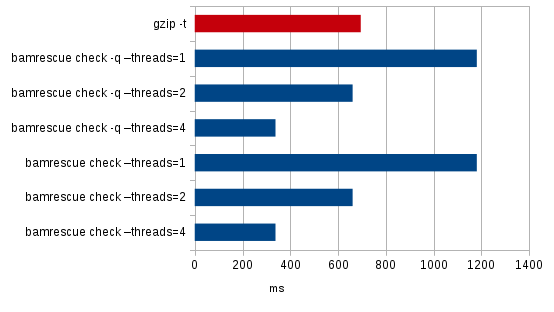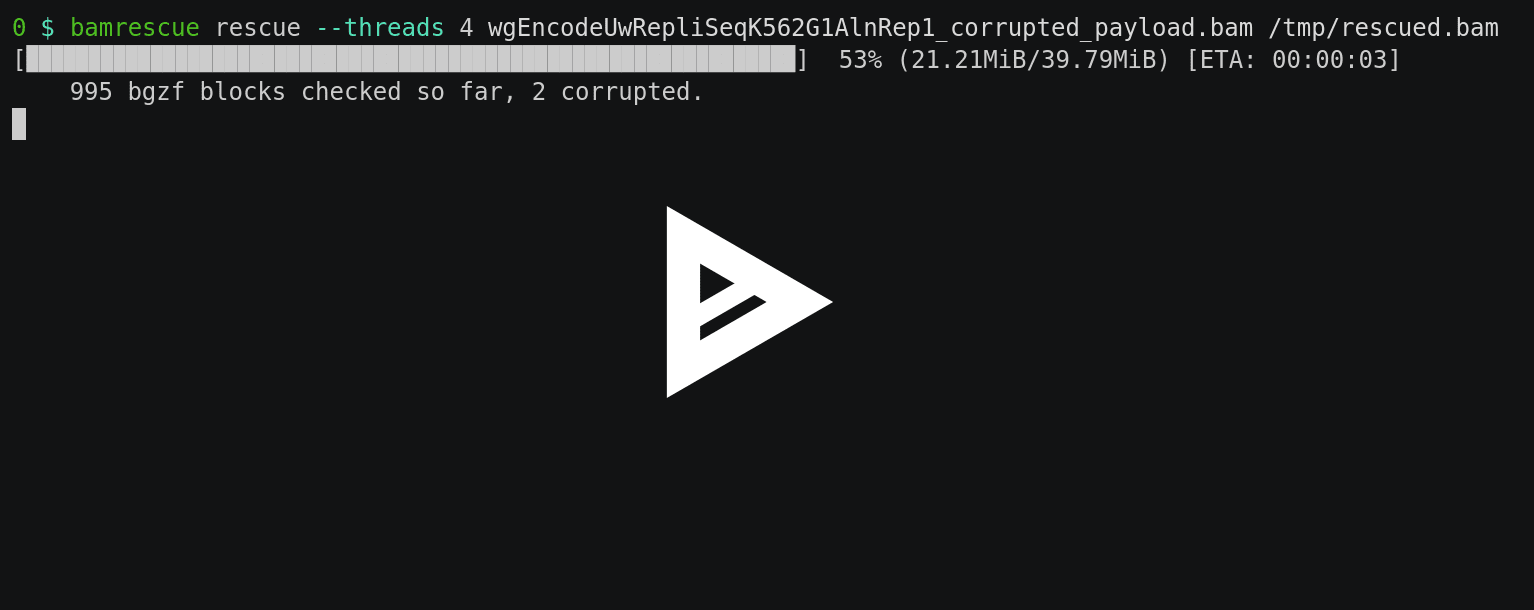bamrescue 





bamrescue is a command line utility to check Binary Sequence Alignment / Map (BAM) files for corruption and rescue as much data as possible from them in the event they happen to be corrupted.
Installation
On ArchLinux and derivatives (Manjaro…)
A PKGBUILD is provided on AUR for ArchLinux and derivatives. It is only tested with an up-to-date ArchLinux.
# Get the PKGBUILD
git clone https://aur.archlinux.org/bamrescue.git
# Add the author's PGP key
gpg --recv-keys FA490B15D054C7E83F70B0408C145ABAC11FA702
# Build and install bamrescue
cd bamrescue
makepkg -si
Alternatively, you can install bamrescue using an AUR helper such as yay:
# Install bamrescue
yay -S bamrescue
On Debian and derivatives (Ubuntu, Mint…)
Pre-built packages are provided for Debian and derivatives. They are only tested with Debian 12 (Bookworm) and Ubuntu 24.04 LTS (Noble).
# Install prerequisites
sudo apt install curl gnupg
# Add the author's PGP key
curl -s https://arkanosis.net/jroquet.pub.asc | sudo tee /usr/share/keyrings/arkanosis.asc
# Add the author's apt stable channel to your apt sources
echo 'deb [arch=amd64 signed-by=/usr/share/keyrings/arkanosis.asc] https://apt.arkanosis.net/ stable main' | sudo tee /etc/apt/sources.list.d/arkanosis.list
# Update and install bamrescue
sudo apt update
sudo apt install bamrescue
In OCI containers (Docker, Podman…)
A Dockerfile is provided for Docker and alternatives. It is only tested with Podman 5.
To create an OCI image from the Dockerfile, run this command:
podman build --tag bamrescue:0.3.0 -f ./Dockerfile
To run an ephemeral container with the created image, run this command:
podman run --rm -it bamrescue:0.3.0 bamrescue --help
You can of course replace --help with the command / option of you choice.
Usage
Usage: bamrescue check [--quiet] [--threads=<threads>] <bamfile>
bamrescue rescue [--threads=<threads>] <bamfile> <output>
bamrescue -h | --help
bamrescue --version
Commands:
check Check BAM file for corruption.
rescue Keep only non-corrupted blocks of BAM file.
Arguments:
bamfile BAM file to check or rescue.
output Rescued BAM file.
Options:
-h, --help Show this screen.
-q, --quiet Do not output statistics, stop at first error.
--threads=<threads> Number of threads to use, 0 for auto [default: 0].
--version Show version.
How it works
A BAM file is a BGZF file (specification), and as such is composed of a series of concatenated RFC1592-compliant gzip blocks (specification).
Each gzip block contains at most 64 KiB of data, including a CRC32 checksum of the uncompressed data which is used to check its integrity.
Additionally, since gzip blocks start with a gzip identifier (ie. 0x1f8b), a fixed gzip method (ie. 0x8) and fixed gzip flags (ie. 0x4), and bgzf blocks include both a bgzf identifier (ie. 0x4243), a fixed extra subfield length (ie. 0x2) and their own compressed size, it is possible to skip over corrupted blocks (at most 64 KiB) to the next non-corrupted block with limited complexity and acceptable reliability.
This property is used to rescue data from corrupted BAM files by keeping only their non-corrupted blocks, hopefully rescuing most reads.
Examples
A bam file of 40 MiB (which is very small by today standards) has been corrupted by two hard drive bad sectors. Most tools (including gzip) choke on the file at the first corrupted byte, meaning that up to 100% of the bam payload is considered lost depending on the tool.
Let’s check the file using bamrescue:
$ bamrescue check samples/corrupted_payload.bam
bam file statistics:
1870 bgzf blocks checked (117 MiB of bam payload)
2 corrupted blocks found (0% of total)
46 KiB of bam payload lost (0% of total)
Indeed, a whole hard drive bad sector typically amounts for 512 bytes lost, which is much smaller than an average bgzf block (which can be up to 64 KiB large).
Even though most tools would gave up on this file, it still contains almost 100% of non-corrupted bam payload, and the user probably wouldn’t mind much if they could work only on that close-to-100% amount of data.
Let’s rescue the non-corrupted payload (beware: this takes as much additional space on the disk as the original file):
$ bamrescue rescue samples/corrupted_payload.bam rescued_file.bam
bam file statistics:
1870 bgzf blocks found (117 MiB of bam payload)
2 corrupted blocks removed (0% of total)
46 KiB of bam payload lost (0% of total)
1868 non-corrupted blocks rescued (100% of total)
111 MiB of bam payload rescued (100% of total)
The resulting bam file can now be used like if it never had been corrupted. Rescued data is validated using a CRC32 checksum, so it’s not like ignoring errors and working on corrupted data (typical use of gzip to get garbage data from a corrupted bam file): it’s working on (ridiculously) less, validated data.
Performance
bamrescue is very fast. Actually, it is even faster than gzip while doing more.
Here are some numbers for a 40 MiB, non-corrupted bam file:
| Command | Time | Corruption detected |
|---|---|---|
| gzip -t | 695 ms | No |
| bamrescue check -q –threads=1 | 1181 ms | No |
| bamrescue check -q –threads=2 | 661 ms | No |
| bamrescue check -q –threads=4 | 338 ms | No |
| bamrescue check –threads=1 | 1181 ms | No |
| bamrescue check –threads=2 | 661 ms | No |
| bamrescue check –threads=4 | 338 ms | No |

Here are some numbers for the same 40 MiB bam file, with two single-byte corruptions (at ~7 MiB and ~18 MiB, respectively):
| Command | Time | Corruption detected | Number of corrupted blocks reported | Amount of data rescuable¹ |
|---|---|---|---|---|
| gzip -t | 93 ms | Yes | N/A | 21 Mio (18%) |
| bamrescue check -q –threads=1 | 157 ms | Yes | N/A | 21 Mio (18%) |
| bamrescue check -q –threads=2 | 91 ms | Yes | N/A | 21 Mio (18%) |
| bamrescue check -q –threads=4 | 56 ms | Yes | N/A | 21 Mio (18%) |
| bamrescue check –threads=1 | 1174 ms | Yes | 2 | 117 Mio (99.99%) |
| bamrescue check –threads=2 | 659 ms | Yes | 2 | 117 Mio (99.99%) |
| bamrescue check –threads=4 | 338 ms | Yes | 2 | 117 Mio (99.99%) |
¹ uncompressed bam payload, rescued using gzip -d or bamrescue rescue

Note: these benchmarks have been run on an Intel Core i5-6500 CPU running Kubuntu 16.04.2 and rustc 1.18.0.
Caveats
bamrescue does not check whether the bam payload of the file is actually compliant with the bam specification. It only checks if it has not been corrupted after creation, using the error detection codes built in the gzip and bgzf formats. This means that as long as the tool used to create a bam file was compliant with the specification, the output of bamrescue will be as well, but bamrescue itself will do nothing to validate that compliance.
Compiling
Run cargo build --release in your working copy.
Contributing and reporting bugs
Contributions are welcome through GitHub pull requests.
Please report bugs and feature requests on GitHub issues.
License
bamrescue is copyright (C) 2017-2024 Jérémie Roquet jroquet@arkanosis.net and licensed under the ISC license.
